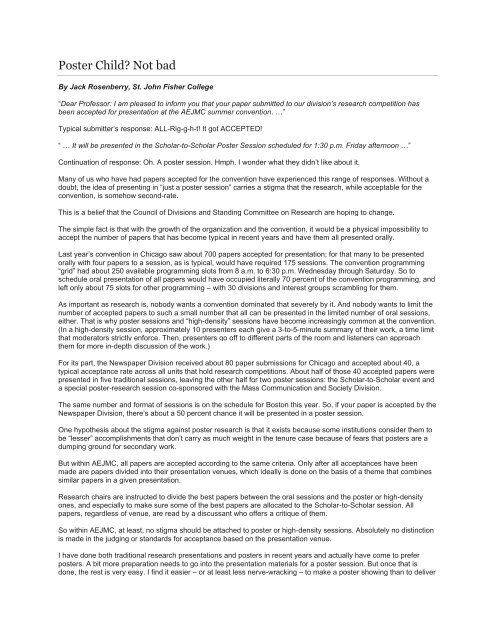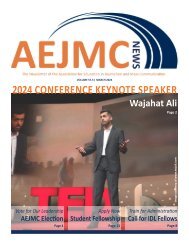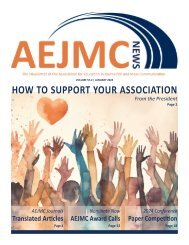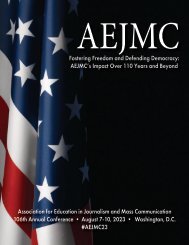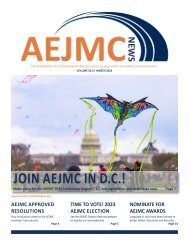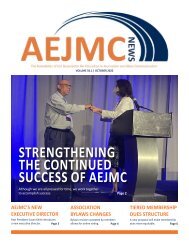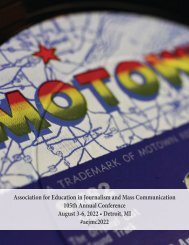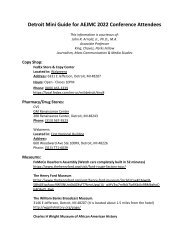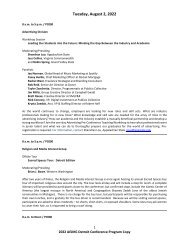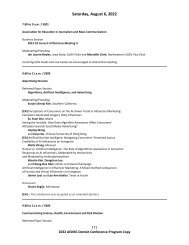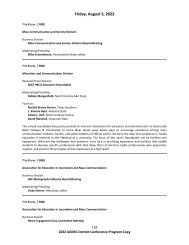Poster Child
Create successful ePaper yourself
Turn your PDF publications into a flip-book with our unique Google optimized e-Paper software.
<strong>Poster</strong> <strong>Child</strong>? Not bad<br />
By Jack Rosenberry, St. John Fisher College<br />
“Dear Professor: I am pleased to inform you that your paper submitted to our division’s research competition has<br />
been accepted for presentation at the AEJMC summer convention. …”<br />
Typical submitter’s response: ALL-Rig-g-h-t! It got ACCEPTED!<br />
“ … It will be presented in the Scholar-to-Scholar <strong>Poster</strong> Session scheduled for 1:30 p.m. Friday afternoon …”<br />
Continuation of response: Oh. A poster session. Hmph. I wonder what they didn’t like about it.<br />
Many of us who have had papers accepted for the convention have experienced this range of responses. Without a<br />
doubt, the idea of presenting in “just a poster session” carries a stigma that the research, while acceptable for the<br />
convention, is somehow second-rate.<br />
This is a belief that the Council of Divisions and Standing Committee on Research are hoping to change.<br />
The simple fact is that with the growth of the organization and the convention, it would be a physical impossibility to<br />
accept the number of papers that has become typical in recent years and have them all presented orally.<br />
Last year’s convention in Chicago saw about 700 papers accepted for presentation; for that many to be presented<br />
orally with four papers to a session, as is typical, would have required 175 sessions. The convention programming<br />
“grid” had about 250 available programming slots from 8 a.m. to 6:30 p.m. Wednesday through Saturday. So to<br />
schedule oral presentation of all papers would have occupied literally 70 percent of the convention programming, and<br />
left only about 75 slots for other programming – with 30 divisions and interest groups scrambling for them.<br />
As important as research is, nobody wants a convention dominated that severely by it. And nobody wants to limit the<br />
number of accepted papers to such a small number that all can be presented in the limited number of oral sessions,<br />
either. That is why poster sessions and “high-density” sessions have become increasingly common at the convention.<br />
(In a high-density session, approximately 10 presenters each give a 3-to-5-minute summary of their work, a time limit<br />
that moderators strictly enforce. Then, presenters go off to different parts of the room and listeners can approach<br />
them for more in-depth discussion of the work.)<br />
For its part, the Newspaper Division received about 80 paper submissions for Chicago and accepted about 40, a<br />
typical acceptance rate across all units that hold research competitions. About half of those 40 accepted papers were<br />
presented in five traditional sessions, leaving the other half for two poster sessions: the Scholar-to-Scholar event and<br />
a special poster-research session co-sponsored with the Mass Communication and Society Division.<br />
The same number and format of sessions is on the schedule for Boston this year. So, if your paper is accepted by the<br />
Newspaper Division, there’s about a 50 percent chance it will be presented in a poster session.<br />
One hypothesis about the stigma against poster research is that it exists because some institutions consider them to<br />
be “lesser” accomplishments that don’t carry as much weight in the tenure case because of fears that posters are a<br />
dumping ground for secondary work.<br />
But within AEJMC, all papers are accepted according to the same criteria. Only after all acceptances have been<br />
made are papers divided into their presentation venues, which ideally is done on the basis of a theme that combines<br />
similar papers in a given presentation.<br />
Research chairs are instructed to divide the best papers between the oral sessions and the poster or high-density<br />
ones, and especially to make sure some of the best papers are allocated to the Scholar-to-Scholar session. All<br />
papers, regardless of venue, are read by a discussant who offers a critique of them.<br />
So within AEJMC, at least, no stigma should be attached to poster or high-density sessions. Absolutely no distinction<br />
is made in the judging or standards for acceptance based on the presentation venue.<br />
I have done both traditional research presentations and posters in recent years and actually have come to prefer<br />
posters. A bit more preparation needs to go into the presentation materials for a poster session. But once that is<br />
done, the rest is very easy. I find it easier – or at least less nerve-wracking – to make a poster showing than to deliver
a formal presentation to a room full of colleagues. (Or to a room devoid of them, which is even worse!) The sessions<br />
allow for a lot of informal chatting with people who are really interested in your work, and I’ve met colleagues at such<br />
sessions who have become close friends and collaborators because of our similar interests.<br />
So, if your work is destined for a poster session, don’t despair. Know that it met the same high standards that every<br />
other accepted paper did (and save this column to show your chair or tenure committee if you need validation of that).<br />
Enjoy the more relaxed setting to show off your fine efforts. And look for me, because I like attending them as much<br />
as I like presenting in them.


